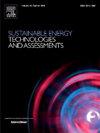Research on remaining useful life prediction method for lithium-ion battery based on improved GA-ACO-BPNN optimization algorithm
IF 7.1
2区 工程技术
Q1 ENERGY & FUELS
Sustainable Energy Technologies and Assessments
Pub Date : 2025-01-01
DOI:10.1016/j.seta.2024.104142
引用次数: 0
Abstract
Lithium-ion battery is the core components of new energy vehicles, and their failures are closely related to the reliability status of new energy vehicles. From engineering practice, the reduced lifespan and performance of lithium-ion batteries can not only easily lead to damage to the power system, but also cause significant economic losses and endanger people’s safety. An improved GA-ACO-BPNN optimization algorithm is established to predict the remaining useful life (RUL) of lithium-ion batteries. This algorithm combines the technical advantages of genetic algorithm (GA) and ant colony optimization (ACO) to improve the back propagation neural network (BPNN) model. Specifically, the path selection mechanism based on the ACO and the updating of pheromones strengthens the search direction of the GA. Additionally, the out-of-bounds judgment ensures that the model parameters remain within a set range, keeping the prediction results in a reasonable space. The results of experiments show that the improved GA-ACO-BPNN optimization algorithm accelerates the convergence speed, fitting speed, and accuracy of the neural network. Compared with traditional models, the prediction accuracy has improved by 3.8%, and it performs well in evaluation indicators such as RMSE, MAE, and MAPE, with a decrease of 59.9%, 72.6%, and 80.1% respectively. It demonstrates stronger robustness in detecting and warning the RUL of the lithium-ion battery and has significant engineering practical value.

求助全文
约1分钟内获得全文
求助全文
来源期刊

Sustainable Energy Technologies and Assessments
Energy-Renewable Energy, Sustainability and the Environment
CiteScore
12.70
自引率
12.50%
发文量
1091
期刊介绍:
Encouraging a transition to a sustainable energy future is imperative for our world. Technologies that enable this shift in various sectors like transportation, heating, and power systems are of utmost importance. Sustainable Energy Technologies and Assessments welcomes papers focusing on a range of aspects and levels of technological advancements in energy generation and utilization. The aim is to reduce the negative environmental impact associated with energy production and consumption, spanning from laboratory experiments to real-world applications in the commercial sector.
 求助内容:
求助内容: 应助结果提醒方式:
应助结果提醒方式:


